2014 FIAT 500L LIVING check engine light
[x] Cancel search: check engine lightPage 187 of 420
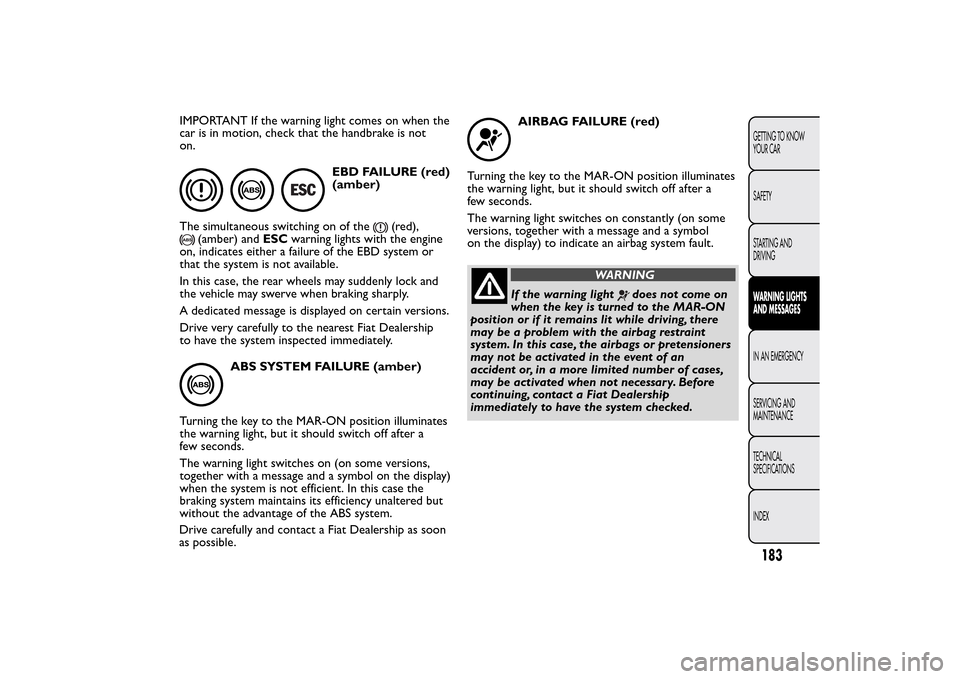
IMPORTANT If the warning light comes on when the
car is in motion, check that the handbrake is not
on.
EBD FAILURE (red)
(amber)
The simultaneous switching on of the
(red),
(amber) andESCwarning lights with the engine
on, indicates either a failure of the EBD system or
that the system is not available.
In this case, the rear wheels may suddenly lock and
the vehicle may swerve when braking sharply.
A dedicated message is displayed on certain versions.
Drive very carefully to the nearest Fiat Dealership
to have the system inspected immediately.
ABS SYSTEM FAILURE (amber)
Turning the key to the MAR-ON position illuminates
the warning light, but it should switch off after a
few seconds.
The warning light switches on (on some versions,
together with a message and a symbol on the display)
when the system is not efficient. In this case the
braking system maintains its efficiency unaltered but
without the advantage of the ABS system.
Drive carefully and contact a Fiat Dealership as soon
as possible.
AIRBAG FAILURE (red)
Turning the key to the MAR-ON position illuminates
the warning light, but it should switch off after a
few seconds.
The warning light switches on constantly (on some
versions, together with a message and a symbol
on the display) to indicate an airbag system fault.
WARNING
If the warning light
does not come on
when the key is turned to the MAR-ON
position or if it remains lit while driving, there
may be a problem with the airbag restraint
system. In this case, the airbags or pretensioners
may not be activated in the event of an
accident or, in a more limited number of cases,
may be activated when not necessary. Before
continuing, contact a Fiat Dealership
immediately to have the system checked.
183GETTING TO KNOW
YOUR CAR
SAFETY
STARTING AND
DRIVINGWARNING LIGHTS
AND MESSAGESIN AN EMERGENCY
SERVICING AND
MAINTENANCE
TECHNICAL
SPECIFICATIONS
INDEX
Page 190 of 420
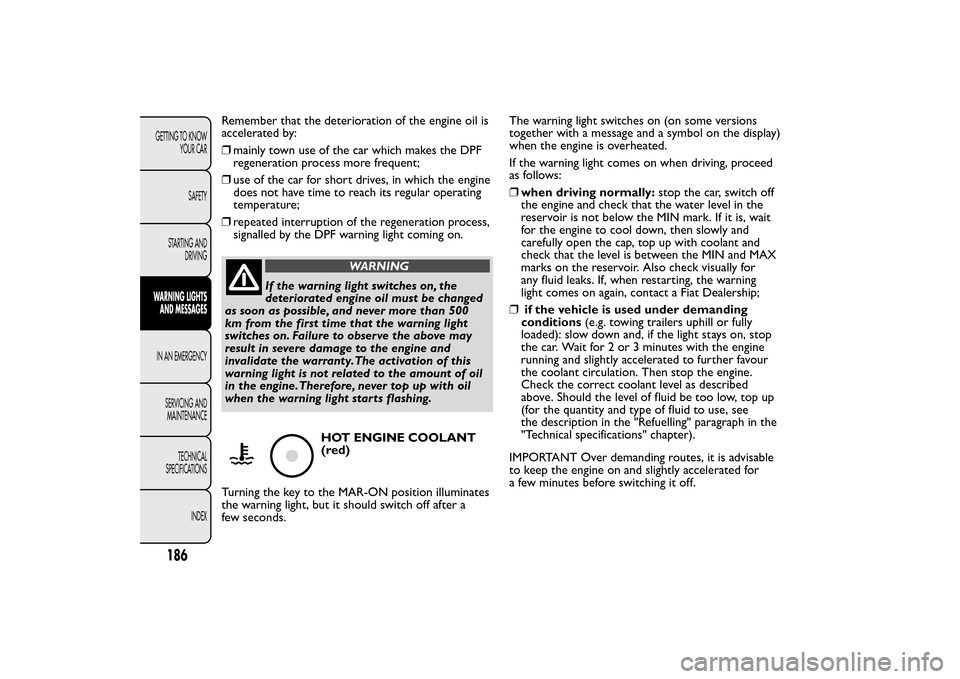
Remember that the deterioration of the engine oil is
accelerated by:
❒mainly town use of the car which makes the DPF
regeneration process more frequent;
❒use of the car for short drives, in which the engine
does not have time to reach its regular operating
temperature;
❒repeated interruption of the regeneration process,
signalled by the DPF warning light coming on.
WARNING
If the warning light switches on, the
deteriorated engine oil must be changed
as soon as possible, and never more than 500
km from the first time that the warning light
switches on. Failure to observe the above may
result in severe damage to the engine and
invalidate the warranty.The activation of this
warning light is not related to the amount of oil
in the engine.Therefore, never top up with oil
when the warning light starts flashing.
HOT ENGINE COOLANT
(red)
Turning the key to the MAR-ON position illuminates
the warning light, but it should switch off after a
few seconds.The warning light switches on (on some versions
together with a message and a symbol on the display)
when the engine is overheated.
If the warning light comes on when driving, proceed
as follows:
❒when driving normally:stop the car, switch off
the engine and check that the water level in the
reservoir is not below the MIN mark. If it is, wait
for the engine to cool down, then slowly and
carefully open the cap, top up with coolant and
check that the level is between the MIN and MAX
marks on the reservoir. Also check visually for
any fluid leaks. If, when restarting, the warning
light comes on again, contact a Fiat Dealership;
❒if the vehicle is used under demanding
conditions(e.g. towing trailers uphill or fully
loaded): slow down and, if the light stays on, stop
the car. Wait for 2 or 3 minutes with the engine
running and slightly accelerated to further favour
the coolant circulation. Then stop the engine.
Check the correct coolant level as described
above. Should the level of fluid be too low, top up
(for the quantity and type of fluid to use, see
the description in the "Refuelling" paragraph in the
"Technical specifications" chapter).
IMPORTANT Over demanding routes, it is advisable
to keep the engine on and slightly accelerated for
a few minutes before switching it off.
186GETTING TO KNOW
YOUR CAR
SAFETY
STARTING AND
DRIVINGWARNING LIGHTS
AND MESSAGESIN AN EMERGENCY
SERVICING AND
MAINTENANCE
TECHNICAL
SPECIFICATIONS
INDEX
Page 191 of 420
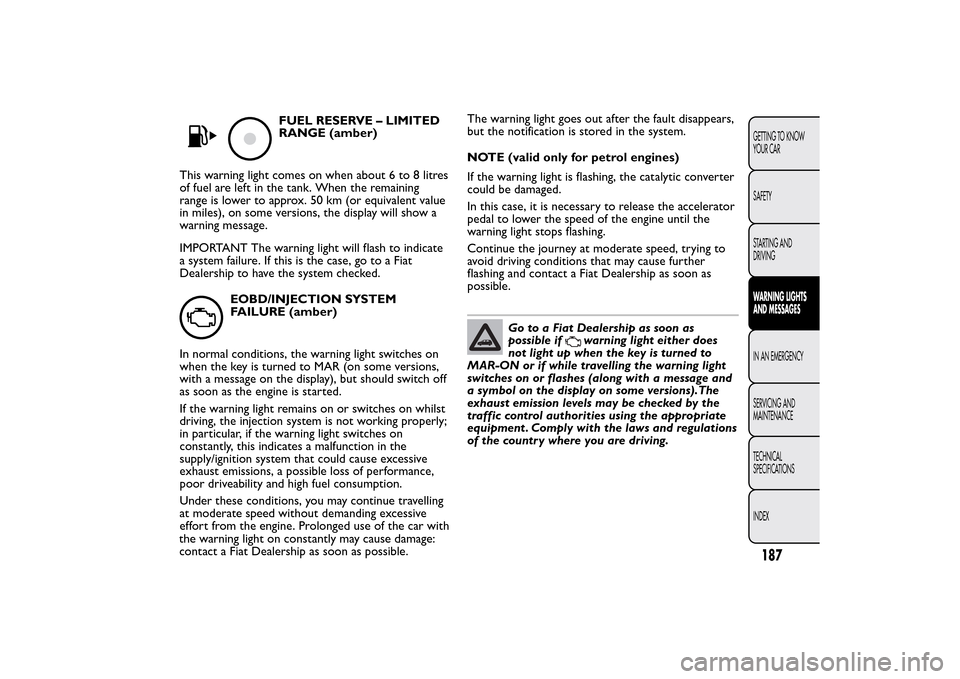
FUEL RESERVE – LIMITED
RANGE (amber)
This warning light comes on when about 6 to 8 litres
of fuel are left in the tank. When the remaining
range is lower to approx. 50 km (or equivalent value
in miles), on some versions, the display will show a
warning message.
IMPORTANT The warning light will flash to indicate
a system failure. If this is the case, go to a Fiat
Dealership to have the system checked.
EOBD/INJECTION SYSTEM
FAILURE (amber)
In normal conditions, the warning light switches on
when the key is turned to MAR (on some versions,
with a message on the display), but should switch off
as soon as the engine is started.
If the warning light remains on or switches on whilst
driving, the injection system is not working properly;
in particular, if the warning light switches on
constantly, this indicates a malfunction in the
supply/ignition system that could cause excessive
exhaust emissions, a possible loss of performance,
poor driveability and high fuel consumption.
Under these conditions, you may continue travelling
at moderate speed without demanding excessive
effort from the engine. Prolonged use of the car with
the warning light on constantly may cause damage:
contact a Fiat Dealership as soon as possible.The warning light goes out after the fault disappears,
but the notification is stored in the system.
NOTE (valid only for petrol engines)
If the warning light is flashing, the catalytic converter
could be damaged.
In this case, it is necessary to release the accelerator
pedal to lower the speed of the engine until the
warning light stops flashing.
Continue the journey at moderate speed, trying to
avoid driving conditions that may cause further
flashing and contact a Fiat Dealership as soon as
possible.
Go to a Fiat Dealership as soon as
possible if
warning light either does
not light up when the key is turned to
MAR-ON or if while travelling the warning light
switches on or flashes (along with a message and
a symbol on the display on some versions).The
exhaust emission levels may be checked by the
traffic control authorities using the appropriate
equipment . Comply with the laws and regulations
of the country where you are driving.
187GETTING TO KNOW
YOUR CAR
SAFETY
STARTING AND
DRIVINGWARNING LIGHTS
AND MESSAGESIN AN EMERGENCY
SERVICING AND
MAINTENANCE
TECHNICAL
SPECIFICATIONS
INDEX
Page 209 of 420
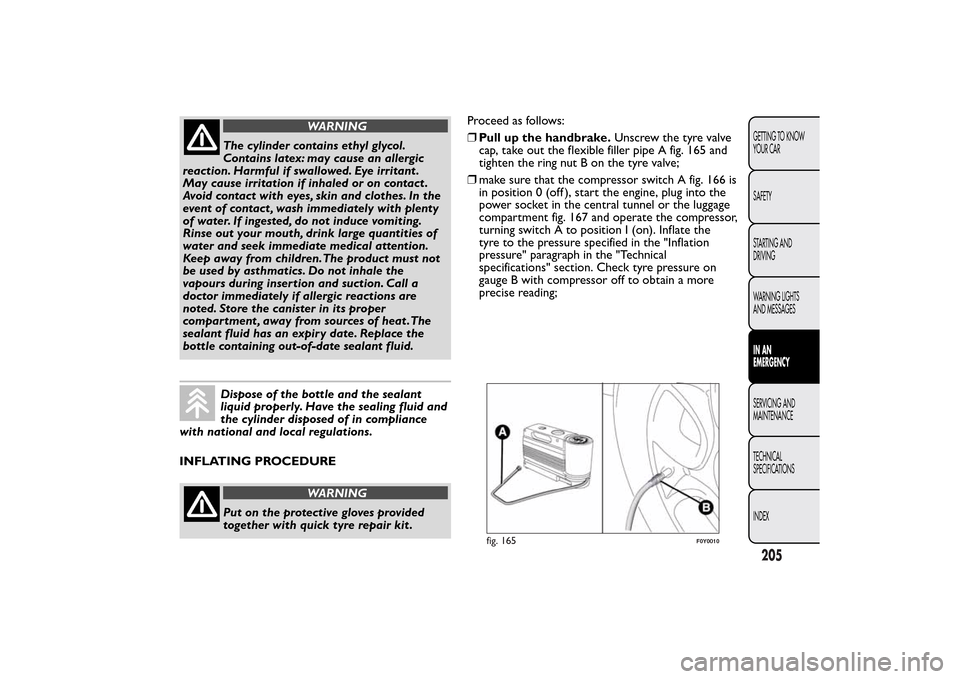
WARNING
The cylinder contains ethyl glycol.
Contains latex: may cause an allergic
reaction. Harmful if swallowed. Eye irritant .
May cause irritation if inhaled or on contact .
Avoid contact with eyes, skin and clothes. In the
event of contact , wash immediately with plenty
of water. If ingested, do not induce vomiting.
Rinse out your mouth, drink large quantities of
water and seek immediate medical attention.
Keep away from children.The product must not
be used by asthmatics. Do not inhale the
vapours during insertion and suction. Call a
doctor immediately if allergic reactions are
noted. Store the canister in its proper
compartment , away from sources of heat .The
sealant fluid has an expiry date. Replace the
bottle containing out-of-date sealant fluid.Dispose of the bottle and the sealant
liquid properly. Have the sealing fluid and
the cylinder disposed of in compliance
with national and local regulations.
INFLATING PROCEDURE
WARNING
Put on the protective gloves provided
together with quick tyre repair kit .Proceed as follows:
❒Pull up the handbrake.Unscrew the tyre valve
cap, take out the flexible filler pipe A fig. 165 and
tighten the ring nut B on the tyre valve;
❒make sure that the compressor switch A fig. 166 is
in position 0 (off ), start the engine, plug into the
power socket in the central tunnel or the luggage
compartment fig. 167 and operate the compressor,
turning switch A to position I (on). Inflate the
tyre to the pressure specified in the "Inflation
pressure" paragraph in the "Technical
specifications" section. Check tyre pressure on
gauge B with compressor off to obtain a more
precise reading;
fig. 165
F0Y0010
205GETTING TO KNOW
YOUR CAR
SAFETY
STARTING AND
DRIVING
WARNING LIGHTS
AND MESSAGESIN AN
EMERGENCYSERVICING AND
MAINTENANCE
TECHNICAL
SPECIFICATIONS
INDEX
Page 229 of 420
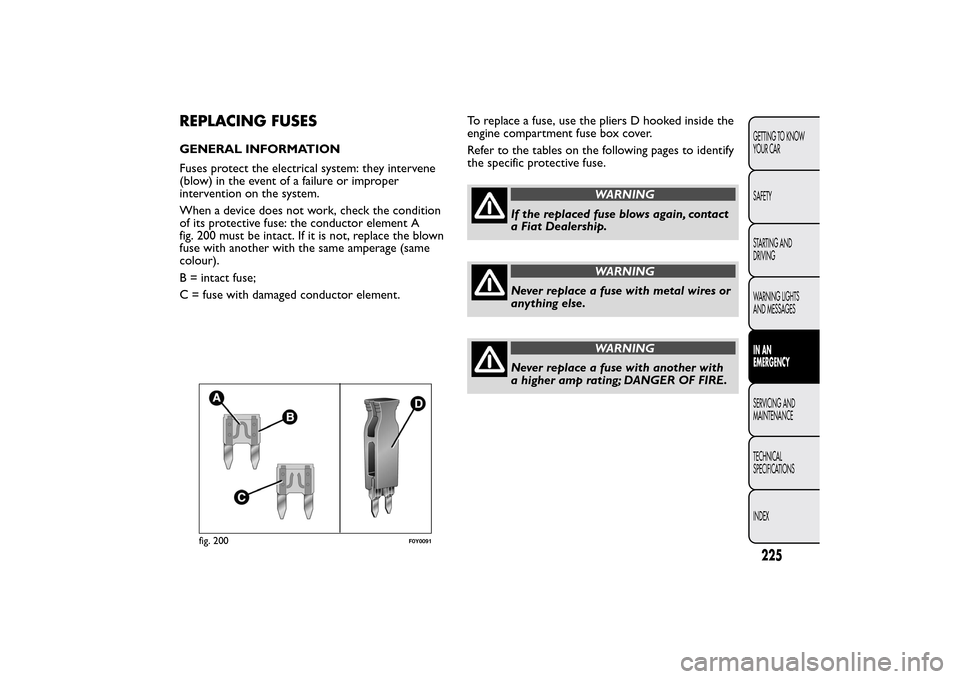
REPLACING FUSESGENERAL INFORMATION
Fuses protect the electrical system: they intervene
(blow) in the event of a failure or improper
intervention on the system.
When a device does not work, check the condition
of its protective fuse: the conductor element A
fig. 200 must be intact. If it is not, replace the blown
fuse with another with the same amperage (same
colour).
B = intact fuse;
C = fuse with damaged conductor element.To replace a fuse, use the pliers D hooked inside the
engine compartment fuse box cover.
Refer to the tables on the following pages to identify
the specific protective fuse.
WARNING
If the replaced fuse blows again, contact
a Fiat Dealership.
WARNING
Never replace a fuse with metal wires or
anything else.
WARNING
Never replace a fuse with another with
a higher amp rating; DANGER OF FIRE.
fig. 200
F0Y0091
225GETTING TO KNOW
YOUR CAR
SAFETY
STARTING AND
DRIVING
WARNING LIGHTS
AND MESSAGESIN AN
EMERGENCYSERVICING AND
MAINTENANCE
TECHNICAL
SPECIFICATIONS
INDEX
Page 243 of 420
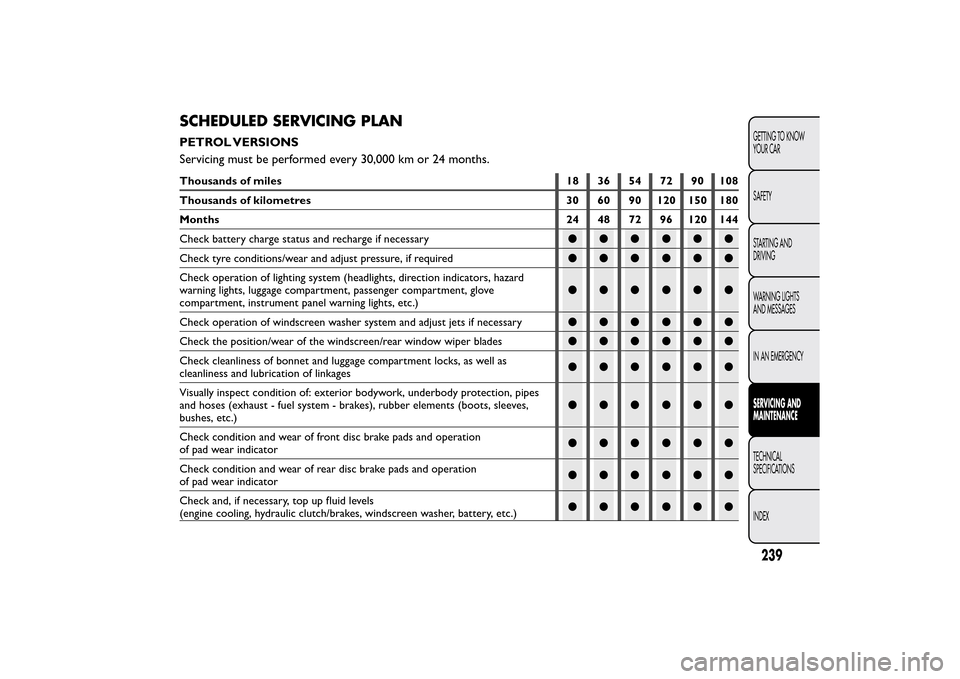
SCHEDULED SERVICING PLANPETROL VERSIONS
Servicing must be performed every 30,000 km or 24 months.Thousands of miles 18 36 54 72 90 108
Thousands of kilometres 30 60 90 120 150 180
Months 24 48 72 96 120 144
Check battery charge status and recharge if necessary●●●●●●
Check tyre conditions/wear and adjust pressure, if required●●●●●●
Check operation of lighting system (headlights, direction indicators, hazard
warning lights, luggage compartment, passenger compartment, glove
compartment, instrument panel warning lights, etc.)●●●●●●
Check operation of windscreen washer system and adjust jets if necessary●●●●●●
Check the position/wear of the windscreen/rear window wiper blades●●●●●●
Check cleanliness of bonnet and luggage compartment locks, as well as
cleanliness and lubrication of linkages●●●●●●
Visually inspect condition of: exterior bodywork, underbody protection, pipes
and hoses (exhaust - fuel system - brakes), rubber elements (boots, sleeves,
bushes, etc.)●●●●●●
Check condition and wear of front disc brake pads and operation
of pad wear indicator●●●●●●
Check condition and wear of rear disc brake pads and operation
of pad wear indicator●●●●●●
Check and, if necessary, top up fluid levels
(engine cooling, hydraulic clutch/brakes, windscreen washer, battery, etc.)●●●●●●
239GETTING TO KNOW
YOUR CAR
SAFETY
STARTING AND
DRIVING
WARNING LIGHTS
AND MESSAGES
IN AN EMERGENCYSERVICING AND
MAINTENANCETECHNICAL
SPECIFICATIONS
INDEX
Page 244 of 420
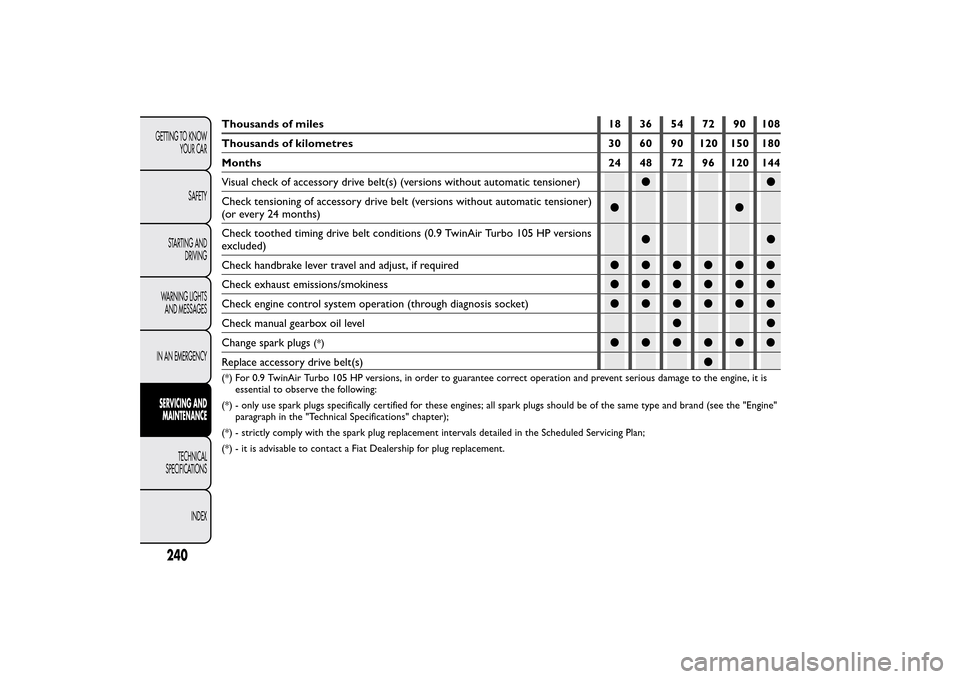
Thousands of miles 18 36 54 72 90 108
Thousands of kilometres 30 60 90 120 150 180
Months 24 48 72 96 120 144
Visual check of accessory drive belt(s) (versions without automatic tensioner)●●
Check tensioning of accessory drive belt (versions without automatic tensioner)
(or every 24 months)●●
Check toothed timing drive belt conditions (0.9 TwinAir Turbo 105 HP versions
excluded)●●
Check handbrake lever travel and adjust, if required●●●●●●
Check exhaust emissions/smokiness●●●●●●
Check engine control system operation (through diagnosis socket)●●●●●●
Check manual gearbox oil level●●
Change spark plugs
(*)
●●●●●●
Replace accessory drive belt(s)●
(*) For 0.9 TwinAir Turbo 105 HP versions, in order to guarantee correct operation and prevent serious damage to the engine, it is
essential to observe the following:
(*) - only use spark plugs specifically certified for these engines; all spark plugs should be of the same type and brand (see the "Engine"
paragraph in the "Technical Specifications" chapter);
(*) - strictly comply with the spark plug replacement intervals detailed in the Scheduled Servicing Plan;
(*) - it is advisable to contact a Fiat Dealership for plug replacement.
240GETTING TO KNOW
YOUR CAR
SAFETY
STARTING AND
DRIVING
WARNING LIGHTS
AND MESSAGES
IN AN EMERGENCYSERVICING AND
MAINTENANCE
TECHNICAL
SPECIFICATIONS
INDEX
Page 246 of 420
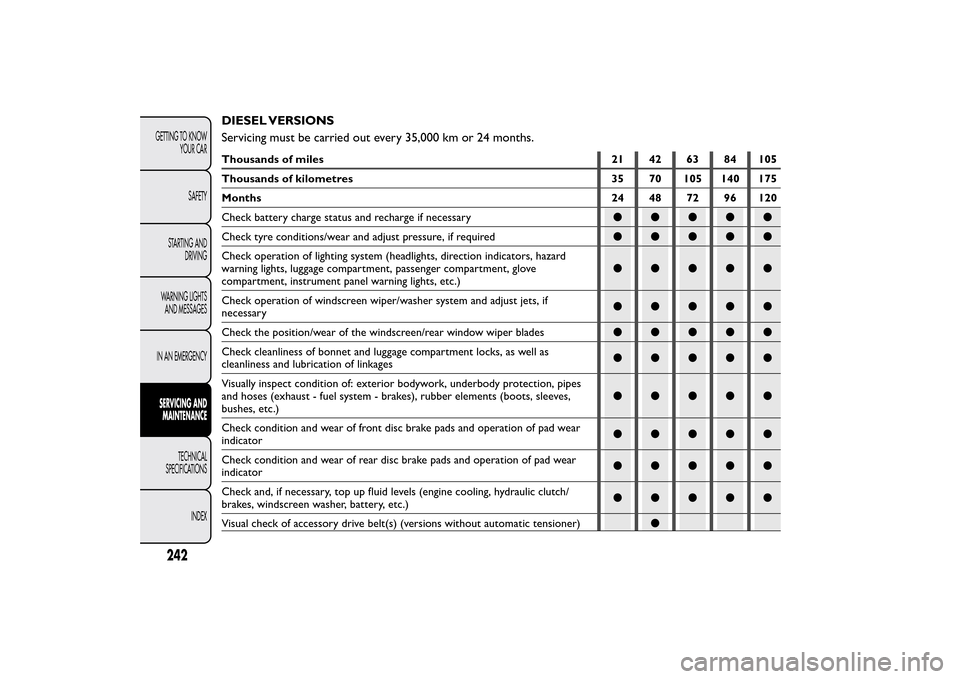
DIESEL VERSIONS
Servicing must be carried out every 35,000 km or 24 months.Thousands of miles 21 42 63 84 105
Thousands of kilometres 35 70 105 140 175
Months 24 48 72 96 120
Check battery charge status and recharge if necessary●●●●●
Check tyre conditions/wear and adjust pressure, if required●●●●●
Check operation of lighting system (headlights, direction indicators, hazard
warning lights, luggage compartment, passenger compartment, glove
compartment, instrument panel warning lights, etc.)●●●●●
Check operation of windscreen wiper/washer system and adjust jets, if
necessary●●●●●
Check the position/wear of the windscreen/rear window wiper blades●●●●●
Check cleanliness of bonnet and luggage compartment locks, as well as
cleanliness and lubrication of linkages●●●●●
Visually inspect condition of: exterior bodywork, underbody protection, pipes
and hoses (exhaust - fuel system - brakes), rubber elements (boots, sleeves,
bushes, etc.)●●●●●
Check condition and wear of front disc brake pads and operation of pad wear
indicator●●●●●
Check condition and wear of rear disc brake pads and operation of pad wear
indicator●●●●●
Check and, if necessary, top up fluid levels (engine cooling, hydraulic clutch/
brakes, windscreen washer, battery, etc.)●●●●●
Visual check of accessory drive belt(s) (versions without automatic tensioner)●
242GETTING TO KNOW
YOUR CAR
SAFETY
STARTING AND
DRIVING
WARNING LIGHTS
AND MESSAGES
IN AN EMERGENCYSERVICING AND
MAINTENANCE
TECHNICAL
SPECIFICATIONS
INDEX